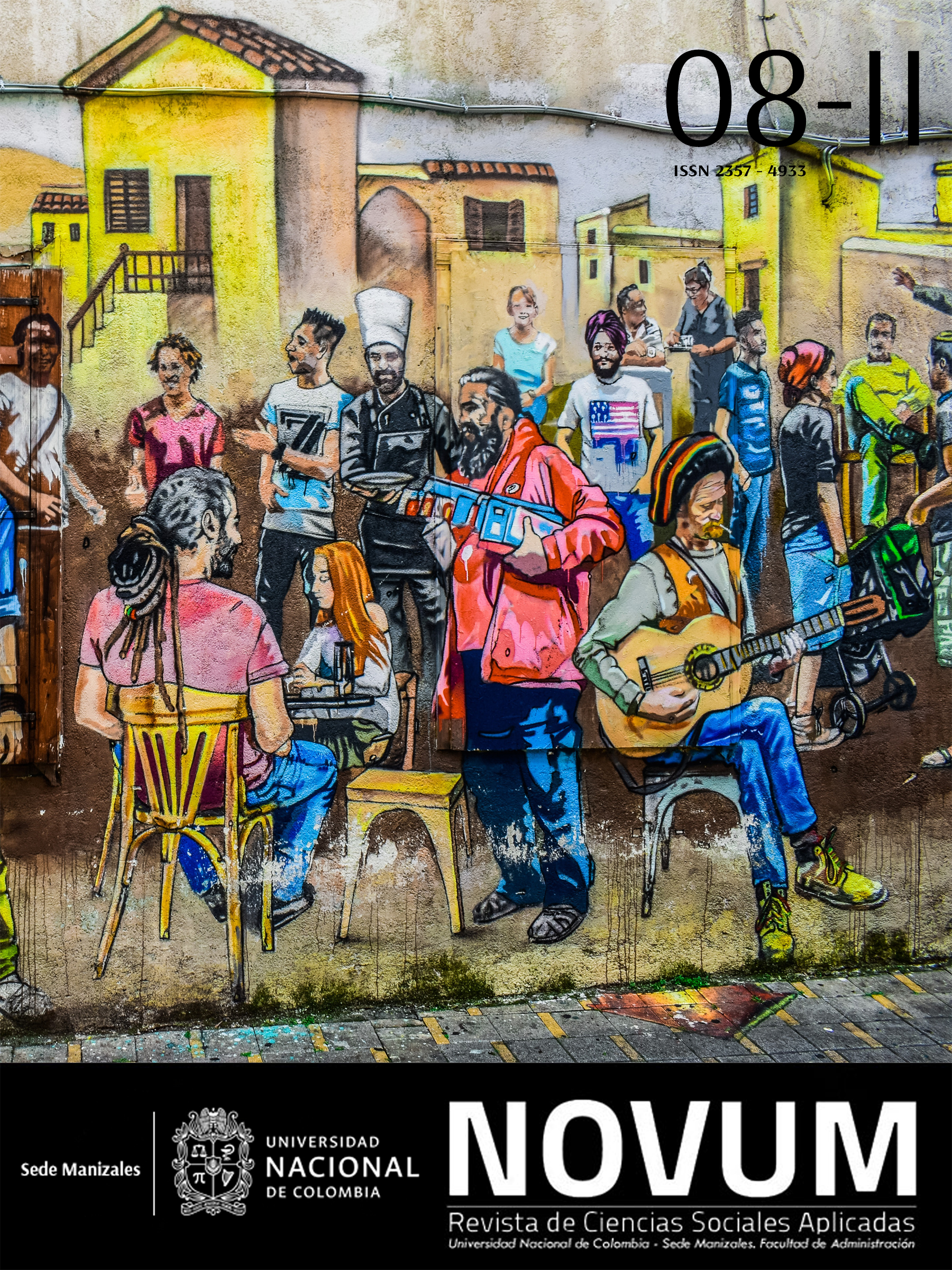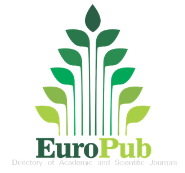Productividad, circulación y consumo de la literatura científica sobre comercio móvil (1996–2018) a partir del análisis bibliométrico
Productivity, circulation and consumption of the scientific literature on mobile commerce (1996-2018) from the bibliometric analysis
Palabras clave:
Comercio Móvil, Indicadores Bibliométricos, Ley de Lotka, Poder Inverso Generalizado, Mínimos Cuadrados. (es)Mobile Commerce, Bibliometric Indicators, Lotka´s Law, Generalized Inverse Power, Least Squares (en)
Descargas
Referencias
Aleixandre-Benavent, R; Valderrama-Zurián, J. C. & González-Alcaide, G. (2016). El factor de impacto de las revistas científicas: limitaciones e indicadores alternativos. El Profesional de la Información, 16(1), 4.
Bain & Company, INC. (2000). El poder de la lealtad del cliente en linea. Bain & Company 2000.pdf, 1-9.
Bakri, A. & Willett, P. (2011). Computer science research in Malaysia: a bibliometric analysis. Aslib Proceedings, 63(2/3), 321-335.
Barnes, S. J. (2002). The mobile commerce value chain: analysis and future developments. International journal of information management, 22(2), 91–108.
Buellingen, F. & Woerter, M. (2004). Development perspectives, firm strategies and applications in mobile commerce. Journal of Business Research, 57(12), 1402-1408.
Buhalis, D. & Deimezi, O. (2004). E-tourism developments in Greece: Information communication technologies adoption for the strategic management of the Greek tourism industry. Tourism and Hospitality Research, 5(2), 103–130.
Büyüközkan, G. (2009). Determining the mobile commerce user requirements using an analytic approach. Computer Standards & Interfaces, 31(1), 144-152.
Chen, Z.-S; Li, R; Chen, X. & Xu, H. (2011). A Survey Study on Consumer Perception of Mobile- Commerce Applications. Procedia Environmental Sciences, 11, 118-124. Clarke, I. (2001). Emerging Value Propositions for M-commerce. Journal of Business Strategies, 18(2), 133.
Clarke, I. (2008). Emerging Value Propositions for M-commerce. Journal of Business Strategies, 25(2), 41-57.
De Bakker, F. G. A., Groenewegen, P., & Den Hond, F. (2005). A Bibliometric Analysis of 30 Years of Research and Theory on Corporate Social Responsibility and Corporate Social Performance. Business & Society, 44(3), 283-317.
Diodato, V. P. & Gellatly, P. (2013). Dictionary of Bibliometrics. Routledge.
Durlacher Research Ltd. (2000). Mobile Commerce Report, 1-65.
Featherman, M. S; Miyazaki, A. D. & Sprott, D. E. (2010). Reducing online privacy risk to facilitate e‐service adoption: the influence of perceived ease of use and corporate credibility. Journal of Services Marketing, 24(3), 219-229.
Federação Brasileira de Bancos (FEBRABAN). (2015). Pesquisa FEBRABAN de Tecnologia Bancária 2015.
García, B. R; González, S. J. & Jornet, M. J. (2010). SPSS: Pruebas no paramétricas. innovaMIDE, 5.
Garfield, E. (1999). Journal impact factor: a brief review. CMAJ: Canadian Medical Association Journal, 161(8), 979-980.
Garfield E. (2006). The History and Meaning of the Journal Impact Factor. JAMA, 295(1), 90-93.
Hsu, C.-L; Wang, C.-F. & Lin, J. C.-C. (2011). Investigating customer adoption behaviours in Mobile Financial Services. International Journal of Mobile Communications, 9(5), 477-494.
Khalifa, M. & Shen, K. N. (2008). Explaining the adoption of transactional B2C mobile commerce. Journal of Enterprise Information Management, 21(2), 110-124.
Khan, A. I; Al-Shihi, H; Al-khanjari, Z. A. & Sarrab, M. (2015). Mobile Learning (M-Learning) adoption in the Middle East: Lessons learned from the educationally advanced countries. Telematics and Informatics, 32(4), 909-920.
Kleijnen, M; Wetzels, M. & De Ruyter, K. (2004). Consumer acceptance of wireless finance. Journal of financial services marketing, 8(3), 206–217.
Lee, W. O. & Wong, L. S. (2016). Determinants of Mobile Commerce Customer Loyalty in Malaysia. Procedia - Social and Behavioral Sciences, 224, 60-67.
Leu, F.-Y; Huang, Y.-L. & Wang, S.-M. (2015). A Secure M-Commerce System based on credit card transaction. Electronic Commerce Research and Applications, 14(5), 351-360.
Li, Y.-M. & Yeh, Y.-S. (2010). Increasing trust in mobile commerce through design aesthetics. Computers in Human Behavior, 26(4), 673-684.
Lin, H.-H. & Wang, Y.-S. (2006). An examination of the determinants of customer loyalty in mobile commerce contexts. Information & Management, 43(3), 271-282.
Machlup, F. (1962). Types of Knowledge and of Knowledge Production. En The Production and Distribution of Knowledge in the United States (pp. 3-43). Princeton University Press.
Mahatanankoon, P; Wen, H. J. & Lim, B. (2005). Consumer-based m-commerce: exploring consumer perception of mobile applications. Computer Standards & Interfaces, 27(4), 347-357.
Malaquias, R. F. & Hwang, Y. (2016). An empirical study on trust in mobile banking: A developing country perspective. Computers in Human Behavior, 54, 453-461.
Maltrás, B. B. (2003). Indicadores Bibliométricos. En Los indicadores bibliométricos: fundamentos y aplicación al análisis de la ciencia (pp. 120-263).
Moed, H. F. & Bordons, M. (1992). The use of bibliometric indicators for the assessment of research performance in the natural and life sciences: Aspects of data collection, reliability, validity and applicability. Revista Española de Documentación Científica, 15(3), 293.
Moed, H. F; De Bruin, R. E; Nederhof, A. J; Van Raan, A. F. J. & Tijssen, R. J. W. (Eds.). (1992). State of the art bibliometric macro-indicators: an overview of demand and supply ; [research evaluation within the Monitor/Spear Evaluation programme of the EC Commission]. Luxembourg: Office for Official Publ. of the Eur. Communities.
Ngai, E. W. T. & Gunasekaran, A. (2007). Mobile commerce: Strategies, technologies, and applications. Decision Support Systems, 43(1), 1-2.
Parasuraman, A. (2005). E-S-QUAL: A Multiple-Item Scale for Assessing Electronic Service Quality. Journal of Service Research, 7(3), 213-233.
Park, C. & Wang, Y. (2013). The Effects of Nationality and Shopping Orientations on Online Shopping Cart Abandonment. International Proceedings of Economics Development and Research, 59, 64.
Price, D. de S. (1976). A general theory of bibliometric and other cumulative advantage processes. Journal of the American society for Information science, 27(5), 292–306.
Price, D. J. D. S. (1982). The parallel structures of science and technology. Science in Context: Readings in the Sociology of Science, 164–76.
Pritchard, A. (1969). Statistical bibliography or bibliometrics. Journal of documentation, 25, 348.
Reichheld, F. F; Markey Jr, R. G. & Hopton, C. (2000). E-customer loyalty-applying the traditional rules of business for online success. European Business Journal, 12(4), 173-179.
Rey-Martí, A; Ribeiro-Soriano, D. & Palacios-Marqués, D. (2016). A bibliometric analysis of social entrepreneurship. Journal of Business Research, 69(5), 1651-1655.
Rousseau, D. M; Sitkin, S. B; Burt, R. S. & Camerer, C. (1998). Not so different after all: A cross-discipline view of trust. Academy of management review, 23(3), 393–404.
Roy, S. B. & Basak, M. (2013). Journal of Documentation: a bibliometric study. Library Philosophy and Practice, 1.
Sadeh, N. (2002). M-commerce: technologies, services, and business models. New York: John Wiley & Sons.
Sánchez, M. M; Dávila, J. A. M. & Berzosa, L. D. (2012). M-tourism: las apps en el sector turístico. En TuriTec 2012. Congreso Turismo y Tecnologías de la Información y las Comunicaciones, Málaga: Facultad de Turismo, Universidad de Málaga (pp. 407–424).
Sancho, R. (2001). Inteligencia competitiva. Barcelona: Universitat Oberta de Catalunya.
Silvente, V. B. & Hurtado, M. J. R. (2012). Clasificación de pruebas no paramétricas. Cómo aplicarlas en SPSS., 5, 13.
Sterling, G. (2016). E-commerce grows robust 16 percent in Q2, according to US Commerce Dept.
Tanveer, S; Azam, F. & Panikar, A. (2007). Mobile advertising: A revolutionary method of business to consumer (B2C) communication for promoting m-governance. ICEG 2007-Hyderabad.
Tiwari, R. & Buse, S. (2007). The mobile commerce prospects: A strategic analysis of opportunities in the banking sector.
Tomás-Casterá, V; Sanz-Valero, J. & Wanden-Berghe, C. (2010). Estudio bibliométrico de la producción científica y uso de la revista chilena de nutrición a través de la red scielo (2002 A 2007). Revista chilena de nutrición, 37(3), 330-339.
Tomás-Castrerá, V. J; Sanz-Valero, J. & Juan-Quilis, V. (2013). Estudio Bibliométrico de la producción científica y de consumo de las revistas sobre nutrición indizadas en la Red SciElo. Universidad de Alicante.
Urbizagástegui, A. R. (2005). La productividad científica de los autores: Un modelo de aplicación de la ley de Lotka por el método del poder inverso generalizado. Información, cultura y sociedad, (12), 51-73.
Urbizagastegui, R. (2009). La ley de Lotka y la literatura de bibliometría. Investigación Bibliotecológica, 13(27).
Vrechopoulos, A. P; Constantiou, I. D; Mylonopoulos, N. & Sideris, I. (2002). Critical success factors for accelerating mobile commerce diffusion in Europe. En Proceedings of the 15th Bled Electronic Commerce Conference (pp. 17–19).
Wang, S. W; Ngamsiriudom, W. & Hsieh, C.-H. (2015). Trust disposition, trust antecedents, trust, and behavioral intention. The Service Industries Journal, 35(10), 555-572.
Wu, J.-H. & Wang, S.-C. (2005). What drives mobile commerce? Information & Management, 42(5), 719-729.
Xu, G. & Gutierrez, J. A. (2006). An Exploratory Study of Killer Applications and Critical Success Factors in M-Commerce: Journal of Electronic Commerce in Organizations, 4(3), 63-79.
Yang, K. C. C. (2005). Exploring factors affecting the adoption of mobile commerce in Singapore. Telematics and Informatics, 22(3), 257-277.
Zhang, J. J; Yuan, Y. & Archer, N. (2001). Driving Forces for M-commerce Success. Research and working paper series, 1(3), 81-104.
Zhang, L. & Liu, Q. (2011). A review for ubiquitous commerce research and application (2000-2009). International Journal of Mobile Communications, 9(1), 39–56.
Zhang, L; Zhu, J. & Liu, Q. (2012). A meta-analysis of mobile commerce adoption and the moderating effect of culture. Computers in Human Behavior, 28(5), 1902-1911.
Zhang, L; Zhu, J. & Liu, Q. (2012). A meta-analysis of mobile commerce adoption and the moderating effect of culture. Computers in Human Behavior, 28(5), 1902-1911.
Cómo citar
APA
ACM
ACS
ABNT
Chicago
Harvard
IEEE
MLA
Turabian
Vancouver
Descargar cita
Visitas a la página del resumen del artículo
Descargas
Licencia
Derechos de autor 2018 Freddy Armando Rodríguez Quintero, Mauricio Escobar Ortega

Esta obra está bajo una licencia internacional Creative Commons Atribución-NoComercial-CompartirIgual 4.0.
Los autores que publiquen en esta revista aceptan las siguientes condiciones:
- La Revista no tiene costos de publicación y/o sometimiento. No se cobrará ningun valor económico al autor que proponga sus artículos a esta publicación.
- La Revista no tiene precio de venta al público y se distribuirá de manera gratuita por medio del Portal de Revistas de la Universidad Nacional de Colombia.
- Los autores conservan los derechos de autor y ceden a la revista el derecho de la primera publicación, con el trabajo registrado con la Attribution-NonCommercial-ShareAlike 4.0 International (CC BY-NC-SA 4.0) que permite a otros distribuir, remezclar, retocar, y crear a partir de la obra de modo no comercial, siempre y cuando den crédito y licencien sus nuevas creaciones bajo las mismas condiciones.
- Los autores pueden realizar otros acuerdos contractuales independientes y adicionales para la distribución no exclusiva de la versión del artículo publicado en esta revista (p. ej., incluirlo en un repositorio institucional o publicarlo en un libro) siempre que indiquen claramente que el trabajo se publicó por primera vez en esta revista.
- Todos los extractos de texto tomados de los artículos publicados en NOVUM deberan ser citados de manera adecuada según la normativa de citación y referenciación (APA, MLA, CHICAGO, etc.).



















